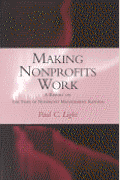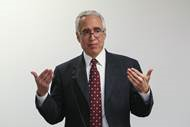Being more like business long has been the proud mantra of government reformers. Presidential candidate Ross Perot rode his corporate credentials to gain 20 percent of the popular vote in 1992, then Vice President Al Gore made being businesslike a central theme of his reinventing government campaign, and George W. Bush entered office as the nation’s first MBA president.
But Enron, WorldCom and Martha Stewart have changed all that. Operating like a business-which used to mean being lean, efficient and customer-focused-has come to mean being devious, manipulative and downright dishonest. No one is about to suggest that government should be more government-like, however. The public still thinks being like government means pretty much what it used to-sluggish, unresponsive and cluttered with red tape. The recent debate over how to build the Homeland Security Department has reinforced that perspective as the president and the Senate face off. One side wants to protect government workers from the president, the other wants to protect the nation from government workers.
If government can’t be more like business, what can it aspire to? The surprising answer is that government should become more like a nonprofit organization. Although business may be more efficient than government, the nonprofit sector has a much more motivated workforce. Its employees have a greater sense of mission, a deeper desire to make a difference and a greater love of their work than any other workforce in America. Find a way to make government more like a nonprofit, and it can only improve.
The evidence comes from a recent Brookings Institution survey of 1,140 nonprofit employees that appeared in the October issue of Nonprofit Quarterly, published by Third Sector New England, a resource organization for the nonprofit sector. The survey is almost identical to two previous Center for Public Service surveys of federal and business employees, also conducted under my direction. After comparing findings from the two surveys, it is clear the nonprofit sector has the healthiest workforce. Nonprofit employees come to work for the right reasons. According to the surveys, more nonprofit employees than those in government or business come to work each morning because they love their jobs and want to help people. Fewer of them come to work for the paycheck, security or benefits.
Unfortunately, nonprofit employees love their work so much that they set themselves up for exploitation. The pay and benefits are so meager that many employees can’t afford to stay for long.
Nevertheless, the nonprofit sector provides the kind of work that many talented Americans want. Those who care about making government more competitive in the talent wars should look at how nonprofits, not the business sector, compete for civic- minded talent. For students who aspire to public service and say, “Show me the work,” not “Show me the money,” the nonprofit sector is the place to go.
According to the center’s research, nonprofit employees are much less likely than federal or business employees to see their work as boring, dead-end jobs. Nonprofit workers more often say they are given a chance to do the things they do best. They can more easily describe how their jobs contribute to their organization’s mission, and many believe they personally contribute to that mission. They also are more satisfied with the chance to develop new skills, gain public respect for their work and accomplish something worthwhile.
The federal government needs much more than a better job search engine to attract these students. They are motivated by commitment to mission, not compensation or fancy job descriptions. What the federal government needs is a recruitment system built on nonprofit values.
Unfortunately, there is one area in which the federal government outdoes the nonprofit sector. Federal employees are much more likely to report problems getting the resources they need to succeed. More than 80 percent of federal employees surveyed said their organizations only sometimes or rarely provide the training they need, compared with about 30 percent of nonprofit employees. And almost 60 percent of federal employees reported that their organizations only sometimes or rarely provided enough employees to do their jobs well, compared with just over 40 percent of the nonprofit workers. Federal employees were almost twice as likely to say there are too many layers between themselves and the top management of their organizations.
These opinions might explain why federal employees are less confident about their sector’s ability to help people, spend money wisely and be fair in its decisions.
The federal government would do well to stop gazing longingly at business as the paragon of performance and start thinking about what gives the nonprofit sector such a big heart. The answers could provide a blueprint for the kind of reforms that would make the federal government work, and might give talented Americans a reason to “go federal” when they take their first job.
The Brookings Institution is committed to quality, independence, and impact.
We are supported by a diverse array of funders. In line with our values and policies, each Brookings publication represents the sole views of its author(s).





Commentary
The Nonprofit Example; Find a way to make government more like a nonprofit, and it can only improve
November 1, 2002